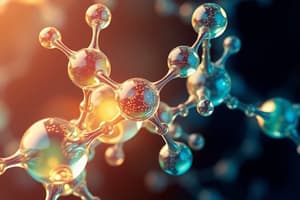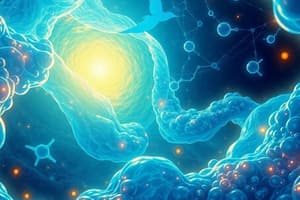Podcast
Questions and Answers
What is the definition of a simple lipid?
What is the definition of a simple lipid?
- Lipids derived from simple and compound lipids by hydrolysis
- Lipids formed of lipid and non-lipid parts
- Lipids formed of fatty acids and non-lipid parts
- Lipids formed of fatty acids and fatty alcohols (correct)
What is the importance of glycerol in the treatment of coronary heart disease?
What is the importance of glycerol in the treatment of coronary heart disease?
- Glycerol can dehydrate tissue due to its water content
- Glycerol is used in pharmaceutical and cosmetic preparations
- Glycerol is miscible with water
- Glycerol acts as a vasodilator (correct)
What is the chemical reaction that occurs when a simple lipid is formed?
What is the chemical reaction that occurs when a simple lipid is formed?
- Fatty acid + Glycerol → Simple lipid + Water
- Fatty acid + Glycerol → Triglyceride + Water
- Fatty acid + Alcohol → Ester + Water (correct)
- Fatty acid + Fatty alcohol → Compound lipid + Water
Which of the following is an example of a simple lipid?
Which of the following is an example of a simple lipid?
What is the importance of glycerol in the treatment of glaucoma?
What is the importance of glycerol in the treatment of glaucoma?
What is the main reason we study lipids?
What is the main reason we study lipids?
Which of the following is a characteristic of lipids?
Which of the following is a characteristic of lipids?
What is the biological importance of lipids primarily related to?
What is the biological importance of lipids primarily related to?
Considering the patient's symptoms described, which lipid function is most likely affected?
Considering the patient's symptoms described, which lipid function is most likely affected?
Which solvent would be most suitable for dissolving lipids?
Which solvent would be most suitable for dissolving lipids?
Which component is NOT present in the structure of lipoproteins?
Which component is NOT present in the structure of lipoproteins?
Which of the following is an example of a monounsaturated fatty acid?
Which of the following is an example of a monounsaturated fatty acid?
What distinguishes essential fatty acids from other fatty acids?
What distinguishes essential fatty acids from other fatty acids?
Which of the following is a compound lipid?
Which of the following is a compound lipid?
What is the primary function of polyunsaturated fatty acids (PUFAs) in the human body?
What is the primary function of polyunsaturated fatty acids (PUFAs) in the human body?
Which of the following fatty acids has the most double bonds?
Which of the following fatty acids has the most double bonds?
Which component is NOT present in the structure of phospholipids?
Which component is NOT present in the structure of phospholipids?
Which of the following is the nitrogenous base present in lecithin?
Which of the following is the nitrogenous base present in lecithin?
What is the primary function of phospholipids in the body?
What is the primary function of phospholipids in the body?
Which lipid component is present in the structure of glycolipids?
Which lipid component is present in the structure of glycolipids?
What is the primary function of glycolipids in the body?
What is the primary function of glycolipids in the body?
What is the defining characteristic of a saturated fatty acid?
What is the defining characteristic of a saturated fatty acid?
What is the main function of chylomicrons?
What is the main function of chylomicrons?
Which of the following is NOT a type of lipoprotein?
Which of the following is NOT a type of lipoprotein?
Which lipoprotein is responsible for reverse cholesterol transport?
Which lipoprotein is responsible for reverse cholesterol transport?
What is the primary function of LDL?
What is the primary function of LDL?
Which of the following is a derived lipid?
Which of the following is a derived lipid?
Which of the following is NOT a derived lipid related to steroids?
Which of the following is NOT a derived lipid related to steroids?
Study Notes
Fatty Acids (FAs)
- A fatty acid consists of a straight chain of an even number of carbon atoms
- Hydrogen atoms are present along the length of the chain and at one end (omega end)
- Carboxyl group (―COOH) is present at the other end (carboxylic end)
- Classification of FAs:
- Saturated FAs: no double bond
- Unsaturated FAs: presence of double bond
- Monounsaturated FAs: contains 1 double bond
- Poly-Unsaturated FA (PUFA): contains more than 1 double bond
- Examples of FAs:
- Saturated FAs: acetic acid (2C), butyric acid (4C), palmitic acid (16C), stearic acid (18C)
- Unsaturated FAs: oleic acid (18C+ 1 double bond)
- PUFA: linoleic acid (18C+ 2 double bonds), linolenic acid (18C+ 3 double bonds), arachidonic acid (20C+ 4 double bonds)
Compound Lipids
- Definition: lipids conjugated with non-lipid groups
- Types of compound lipids:
- Phospholipids (PLs): lipid part + phosphoric acid
- Glycolipids: lipid part + carbohydrate
- Sulpholipids
- Lipoproteins: lipid part + protein
Phospholipids (PLs)
- Structure: lipid part (fatty acid + glycerol) + phosphoric acid + nitrogenous base
- Nitrogenous bases:
- Choline
- Ethanolamine/serine
- Functions of PLs:
- In cell membrane
- Blood coagulation
- Lipotropic factor (prevent lipid accumulation in the liver)
- Lung surfactant (preventing lung collapse)
Glycolipids
- Structure: lipid part (fatty acid) + carbohydrate
- Function: act as electric insulators of nerve impulses in nervous tissues
Lipoproteins
- Structure: lipid part (phospholipid, cholesterol, triglyceride) + protein (apoprotein)
- Functions of lipoproteins:
- Cell membrane structure
- Lipid transport in the blood
- Types of lipoproteins:
- Chylomicrons (CM)
- Very Low Density Lipoprotein (VLDL)
- Low Density Lipoprotein (LDL)
- High Density Lipoprotein (HDL)
Derived Lipids
- Definition: compounds derived from simple lipids and compound lipids by hydrolysis
- Types of derived lipids:
- Fatty acids
- Glycerol
- Cholesterol
- Steroid hormones (sex hormones)
- Vitamin D
- Bile acids and salts
Studying That Suits You
Use AI to generate personalized quizzes and flashcards to suit your learning preferences.
Description
Test your understanding of lipid chemistry by defining lipids, summarizing their biological importance, classifying them, and describing the structure and function of fatty acids, phospholipids, and lipoproteins. Apply your knowledge to a clinical case scenario involving a 57-year-old male patient with chest pain.




